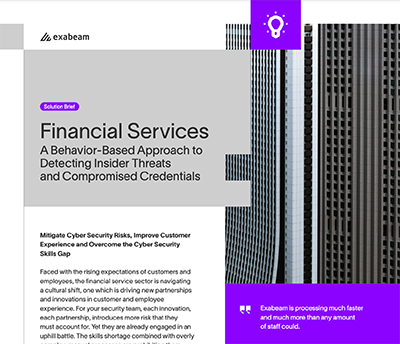Mitigating Risk: How the Financial Services Sector Is Handling Today’s Cybersecurity Challenges

Like many industries, financial institutions face ongoing challenges from the threat of cybersecurity attacks. Attacks may come in the form of ransomware, credential theft, or fraud, all of which put customer assets at risk of theft and other issues. Not only does this harm customer relationships, but it can also cause permanent damage to your institution’s reputation, costing you future accounts.
As hard as you work to keep your systems safe, cyberattackers can still find ways to slip through. In our industry solution brief, “Financial Services: A behavior-based approach to detecting insider threats and compromised credentials,” we discuss the challenges facing businesses in the financial services sector.
In this article:
- The cybersecurity problem facing the financial services industry
- How behavioral analytics benefits technology and financial services
- Improving the customer experience
- Mitigating cyber risk
- Further reading
The cybersecurity problem facing the financial services industry
For this solution brief, we took an in-depth look at the cybersecurity issues plaguing financial services. The first step toward ensuring these businesses are protected is understanding these challenges. They include:
- Mitigating cybersecurity risk
- Customer experience and retention
- Overcoming the cybersecurity skills shortage
One common thread running throughout the brief is the skills shortage hitting financial institutions particularly hard. Finding the specialists necessary to keep your data safe isn’t easy, and keeping those positions filled is even tougher. Though the problem is easing a bit, according to Cybersecurity Ventures’ 2021 Cybersecurity Jobs Report, which finds that “for the first time in a decade, the cybersecurity skills gap is leveling off. Looking five years ahead, we predict the same number of openings in 2025”.
However, we’re not out of the woods yet. To help relieve some of the strain, the brief demonstrates a solution that involves automating part of your team’s tasks. Importantly, automation gives cybersecurity professionals the tools they need to take their cybersecurity operations to the next level.
How behavioral analytics benefits technology and financial services
Financial institutions already rely heavily on technology to address the most common threats they face and are currently focusing on:
- Compromised insider threats
- End-to-end network visibility
- Incident prioritization
- Securing cloud services and monitoring cloud infrastructure
Exabeam’s solution uses behavioral analysis to detect and prevent cybersecurity incidents. The software runs in the background, gathering data on your systems and learning typical behaviors. In doing so, the solution is then able to detect atypical behavior quickly, in real time, and alert your team to it.
This technology monitors activity on your network, SWIFT transactions, and even your cloud instances. This helps with all the above-mentioned risks. With insider threats, for instance, machine learning monitors how your employees typically behave so that when something out of the ordinary happens, you’ll know before it escalates.
Improving the customer experience
Today’s financial services businesses face an ongoing challenge when it comes to user experience. Winning and retaining customers means ensuring that technology not only keeps their data safe, but also provides a reliable experience. A security breach that impacts your ability to transact online, for instance, creates as bad an encounter as visiting a branch where a teller is unfriendly.
The brief illustrates how Exabeam uses Smart Timelines™ to ensure your systems remain online and accessible. As competitors invest in tools that similarly protect their systems against breaches, it’s more important than ever that financial institutions do the same. Through Smart Timelines™, you’ll be able to see where you need more coverage so that you can shift your resources to those areas.
Mitigating cyber risk
The financial industry already knows the importance of keeping risk at a minimum. Cybersecurity is another aspect of this, added to the work industry executives do to ensure their assets are safe and secure. As institutions deal with increased risk to data and the skilled cybersecurity labor shortage, the demand for technology that can reduce risk will be higher than ever.
Keeping up with ever-changing technologies has become an ongoing challenge for financial institutions. Any new implementation means taking a look at the risk. Will it take the website offline, even for a short time? Can it be done without putting data in jeopardy? By familiarizing themselves with their network infrastructure and typical behaviors, financial institutions will be prepared to implement new technologies and include reducing those risks as part of the planning process.
Learn more about Financial Services sector
Want to learn more about how the financial services sector is managing today’s cybersecurity challenges? Download Exabeam’s industry solution brief, “Financial Services: A behavior-based approach to detecting insider threats and compromised credentials”.

Similar Posts
Recent Posts
Stay Informed
Subscribe today and we'll send our latest blog posts right to your inbox, so you can stay ahead of the cybercriminals and defend your organization.
See a world-class SIEM solution in action
Most reported breaches involved lost or stolen credentials. How can you keep pace?
Exabeam delivers SOC teams industry-leading analytics, patented anomaly detection, and Smart Timelines to help teams pinpoint the actions that lead to exploits.
Whether you need a SIEM replacement, a legacy SIEM modernization with XDR, Exabeam offers advanced, modular, and cloud-delivered TDIR.
Get a demo today!











